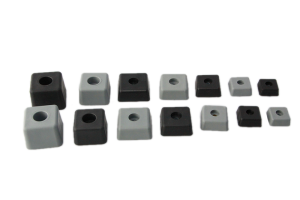 When it comes to designing and manufacturing rubber bumpers or feet, understanding durometer is essential. Durometer is one of the most common ways to measure the hardness of a material, particularly for polymers, elastomers, and rubbers. It plays a critical role in determining how a product performs under pressure, impact, and varying environmental conditions.
When it comes to designing and manufacturing rubber bumpers or feet, understanding durometer is essential. Durometer is one of the most common ways to measure the hardness of a material, particularly for polymers, elastomers, and rubbers. It plays a critical role in determining how a product performs under pressure, impact, and varying environmental conditions.
What Is Durometer?
Durometer refers to the resistance of a material to permanent indentation. In simple terms, it measures how “hard” or “soft” a rubber compound is. The test involves pressing a standardized indenter (or presser foot) into the surface of the material using a defined amount of force and measuring the depth of the indentation.
A harder material will resist indentation and produce a higher durometer reading, while softer materials will indent more easily, resulting in a lower durometer value. The test must be performed under controlled conditions to ensure accuracy—applying the force smoothly, without shock, and reading the measurement at a consistent time interval.
Common Durometer Scales
Rubber and elastomer hardness is most often measured on the Shore A scale. For example:
-
Soft rubber compounds (like flexible seals or gaskets) might measure around 40–60 Shore A.
-
Medium compounds (like general-purpose bumpers or feet) are typically 70–80 Shore A.
-
Hard compounds (used for heavy machinery or high-impact equipment) can measure 85–95 Shore A.
At Budwig Molded Products, our standard thermoplastic rubber feet are manufactured at 87 Shore A, striking the perfect balance between flexibility and strength. However, we can also produce custom durometers—softer or harder—depending on your application needs.
Beyond Durometer: Other Factors to Consider
While durometer is an important measure of performance, it’s only one part of the equation when choosing the right rubber feet or bumpers. You should also consider:
-
Load distribution: How many bumpers are supporting the equipment.
-
Environmental exposure: Resistance to ozone, UV, chemicals, or extreme temperatures.
-
Application type: Whether it’s static or dynamic (stationary vs. vibrating machinery).
-
Abrasion and impact resistance: For long-term durability and stability.
Selecting the proper material and durometer ensures your equipment is supported securely and protected from wear, vibration, and environmental stress.
Explore Budwig’s full line of injection-molded rubber feet and bumpers at BudwigMoldedProducts.com to find the ideal solution for your next project.






 We sell only what we manufacture at our facility in San Diego, California.
We sell only what we manufacture at our facility in San Diego, California.